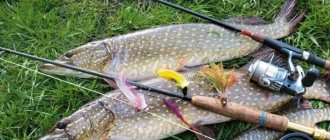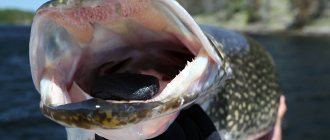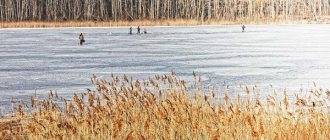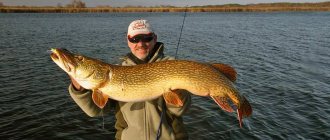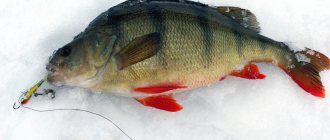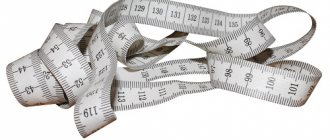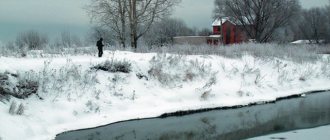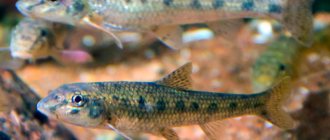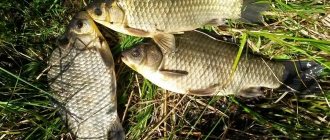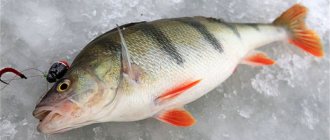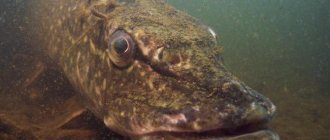The fact that fish are weather-dependent creatures has long been proven by scientists; fishermen confirm this fact based on their own experience. Therefore, when going fishing, they take into account weather conditions, knowing that in the heat the activity of the fish is minimal, and periods of cold weather contribute to an increase in metabolism, forcing aquatic inhabitants to eat intensely. Each species has its own habits and predilections for pecking under different conditions. Often the behavior of predators differs significantly from the habits of white fish. Thus, air temperature, precipitation, cloudiness, wind, and atmospheric pressure are of no small importance for pike fishing. Therefore, the expression “pike weather” is often heard among predator hunters.
What pressure is best for fishing in winter when catching predators and peaceful fish
In addition to subjective factors, such as incorrectly configured equipment or its inept use by a fisherman, natural factors can also influence the lack of bite.
One of the most important conditions for successful fishing is suitable atmospheric pressure.
, which can be either low or high. In this article, we will look in detail at what pressure is best for fishing in winter, and also pay attention to the most important points that every fisherman definitely needs to know.
Fish biting and the influence of southern and western winds on it
As you know, the south and west winds are the most favorable for fishing and fish behavior. But from the previous chapter we realized that this is a little incorrect and incorrect. Weak, moderate southern and western winds simply do not affect the movement of river inhabitants from their permanent and familiar habitats to new temporary ones, due to the absence of changes in the underwater current, movement of food and a gradual decrease in atmospheric pressure, which we also discussed above. But strong gusts of southern and western wind can have a very detrimental effect on fishing, due to a sharp change in atmospheric pressure (fish do not tolerate sudden changes in atmospheric pressure) and all the same changes in water layers, which will also greatly affect the habitat of fish in that area. or other place. So, friends, if before fishing the weather forecast shows moderate gusts of southern and western winds, feel free to go to your usual fishing spots.
It is important to take into account one point - the east and west wind can be either cold or warm, it depends on many factors, such as the time of year, region and seasonality of the winds. Happy fishing everyone!
Increased and decreased
Before we talk about how changes in pressure affect the fishing process, let’s briefly look at what atmospheric pressure is, as well as which value is normal, and which is high or low.
Atmospheric pressure is the force with which air (aka the atmosphere) presses on the surface of the earth and the objects on it. Air has its own mass, and therefore has a similar effect. The strong influence from the outside is balanced by the force of pressure inside living organisms.
The normal value with which air affects the surface of the earth is 760 mm Hg.
This is equivalent to the fact that the air creates a force of 1.033 kg per 1 cm square of the earth's surface. Any fluctuations in the pressure of air masses mean a change in the force of the air, which is felt by every living organism on the planet.
Naturally, fish are no exception, and therefore it is logical that they change their behavior under low or high pressure. The fisherman, in turn, needs to know the behavior of a particular fish when the pressure changes, otherwise he risks being left without a catch where there was an intense bite yesterday.
Optimal conditions for pike fishing in autumn
Best atmospheric pressure
As mentioned above, atmospheric pressure affects the effectiveness of pike fishing. In good weather, to catch a predator, you need to combine several factors - pressure, wind direction and strength, rain and cloudiness . Because everything matters.
The most influential of pressure, wind direction and wind strength is atmospheric pressure. Low pressure is almost always on cloudy days. The pike bite on such days is better than in clear weather. However, if it is consistently clear for several days, then the chances of a bite are higher than if the weather changes daily. The best atmospheric pressure for effective pike fishing in the fall is a stable pressure in the range from 750 to 760 mm Hg. If it remains constant for 2-3 days, then the bite should be good. At low pressure, pike are caught better, since in such weather small fish swim deeper. Just where the predator likes to hunt. Its activity depends on the availability of sufficient food.
In what weather does pike bite best in autumn?
For catching a predator in the fall, the best weather is a breeze and light rain that lasts for several days. The pike bite is less intense on warm days. In cloudy weather and stable atmospheric pressure, between 11.30 and 13.30, active biting can be observed. And the bait should be placed a little higher than at the very bottom.
The best weather conditions are:
- no temperature changes (between night and day);
- cloudy weather for several days;
- stable atmospheric pressure;
- slight southwest, south or west wind;
- drizzling rain.
Autumn zhor
The weather affects the pike's bite, but in the fall it prepares for winter, so it actively feeds. Attacks prey confidently. It will be difficult to release the bait with bare hands, since during this period the predator usually swallows the prey.
This period is called the autumn feeding period of pike. This is one of the most productive periods for catching it. During this period she becomes strong, as she eats well. This period begins at a time when the temperature in the reservoir is approximately 13–15 °C.
The behavior of the fish changes, they spread throughout the entire reservoir, since the conditions are the same everywhere. During the autumn feeding season, pikes become more active. They begin to hunt, rather than loiter at springs and springs. The pike, sensing the approach of winter, fattens up.
The pike bite is influenced by various weather phenomena: wind, precipitation and atmospheric pressure. If you are going to go fishing for this predator, then you need to know the weather forecast, monitor changes in weather conditions and be prepared for any changes. However, not only weather conditions affect the pike bite. Therefore, for successful fishing, you need to take into account all the factors together, and then your fishing will go with a bang.
Source
Changing fish behavior
The period of change in the barometer value negatively affects the fishing process.
This is the moment when the fish begins to react to changing external conditions and rebuild its behavior.
During this period, we can say that fishing is in limbo, since with increased or decreased pressure, each fish behaves differently. Some species pass into a passive state, others begin active life. Of course, it is important for a fisherman to be able to recognize signs of pressure changes in time and rearrange the fishing process in advance.
Attention!
The value of air mass pressure allows the fisherman to correctly determine which fish will be more active under given weather conditions. Based on his observations, he can prepare for fishing accordingly!
If the force of influence of air masses on the surface of reservoirs begins to decrease, then predatory fish react violently to this factor.
This is the optimal time for her hunting, since it is during this period that her prey begins to behave passively, thereby significantly facilitating the process of hunting her.
For peaceful fish, the most active period of life begins when atmospheric pressure rises.
Therefore, the fisherman needs to determine from external weather conditions what pressure currently prevails.
Cyclones and anticyclones
In a cyclone, winds blow in a circular path, moving air masses to a low pressure zone, towards the center. In anticyclones, the opposite is true: in the center there is a zone of high pressure and the wind moves air from the center outward, also in a circle.
The figure shows diagrams of the movement of air masses and wind directions during cyclones and anticyclones.
During a cyclone, condensation of water vapor occurs, so the weather deteriorates, the wind increases, rains and thunderstorms begin, the temperature drops - in summer, in winter - snowfalls and snowstorms come, cloudiness and thaws occur. The air mainly moves from west to east at a speed of 20-80 km/h.
Therefore, a cyclone moving across the area from west to east first finds itself with a south wind, which then turns into a southeast, northeast and north. Atmospheric pressure drops.
An anticyclone is exactly the opposite.
It moves in the direction of the general air movement from west to east, at a speed of up to 30 km/h. When the speed of the anticyclone disappears, drought occurs in the place where it stopped in the summer months.
The anticyclone manifests itself with a northwestern or fading northern wind, then many days of little or cloudless weather sets in and ends with an intensifying southwestern or southern wind.
Signs of pressure changes
First of all, when going fishing, a fisherman can always find out the value of atmospheric pressure using a home barometer
. This will allow him to decide what gear to take and what fish to start hunting for.
However, you always need to be on guard, since during the day the weather, and therefore the air pressure, can change. For example, if there is fog in the early morning, then the weather is likely to improve and the atmospheric pressure to increase. If the weather worsens, gusts of wind are a clear sign that air pressure will decrease.
Factors influencing fishing:
- ambient temperature;
- wind direction and strength;
- degree of illumination.
There is a relationship between air pressure and its temperature.
In winter, at low pressure, the air is characterized by a higher temperature than at high pressure. However, the temperature itself does not affect the bite, since conditions at depth are completely different. On the contrary, high pressure is characterized by frosty but calm weather. Typically these conditions are clear and there is virtually no significant wind movement.
Moon
And finally, the most obvious of all the secondary factors influencing the behavior of pike in winter is the phases of the moon. Some fishermen deliberately neglect this phenomenon, which may be in vain. Experienced fishermen have noticed that it is the pike that more than others depends on whether the Moon is “young” or “old”. On some lunar days the fish behave actively, while during other phases the bite disappears altogether. It is believed that the predator’s peak activity is reached in the first 7 lunar days, as well as in the period from the 17th to the 21st. The rest of the time, the fish leads a more sedate lifestyle and hunts less often.
Optimal pressure for winter fishing
Practice shows that the most successful fishing in winter occurs when there is a stable value of atmospheric pressure for several days
. However, it would be wrong to say that any particular value is preferable for fishing. The main thing is the constancy of the pressure of the air masses, since this means constancy in the behavior of the fish.
If there is low blood pressure or a decrease in pressure, then you need to be prepared for the fact that behavioral activity in predatory fish will soon increase.
Important!
The fisherman needs to understand that a change in the force of the influence of air masses will not mean the cessation of the bite, but its change. This means that you need to reconfigure everything, and until you guess correctly with the gear, bait, hooks, there will be no bite.
Peaceful fish, on the contrary, show peak activity at elevated pressure, which is considered almost ideal. This will allow the fisherman to correctly navigate which fish to prepare gear and bait for. However, it should also be taken into account that the success of fishing is influenced by a number of other natural factors, some of which are not inferior in importance to atmospheric pressure.
This means that the force of the air masses, although an important reference point for the fisherman, is by no means the only one. Therefore, you need to take into account a combination of factors for successful fishing.
Pike, zander and perch
Pike, pike perch or perch are predatory fish, and therefore they always have a good appetite, since they constantly need to provide themselves with energy. This leads to the fact that these predatory inhabitants of the reservoir are always in search of food. However, changes in atmospheric pressure also affect their behavior. If there is low pressure, then these fish “master” everything within their habitat.
This pressure is favorable, but when it is elevated, everything changes.
It is believed that if the pressure of the air masses has increased, then the predator will not peck. But this is not an entirely true statement. It’s just that the predator has no appetite at this time; peaceful fish are at the peak of their activity, and therefore they become difficult prey. That is why predatory fish remain more in one place, being satisfied only with the prey that falls.
It is impossible to say that at a certain mercury level, the fish will be caught well or poorly. This fact depends on a number of additional conditions.
Atmospheric pressure, how it affects the pike bite, and at what pressure the pike is most active
Hello everyone, today we will discuss how atmospheric pressure affects pike biting.
It is worth noting that we do not pay so much attention to changes in temperature and other factors. As this happens with fish, different species can be active under certain weather conditions. They are similar in one thing: activity drops with sudden changes in any direction.
We must take into account what this predator eats every day. But feeding times always change. An adult eats about a dozen fish per day, the weight of which does not exceed 250 grams.
Pressure in this case is quite closely related to the activation of zhor in pike. This species loves low blood pressure but can also remain at low blood pressure.
But the main thing is that it remains stable for about three days, then in the end the bite will be good. These are the optimal conditions under which pike bite on different types of bait.
Even minor changes may have little effect on the activity of the predator. The diet simply becomes more modest; when constant changes are observed, the pike begins to take almost any food.
Even under such conditions, the bite will not stop completely. Experienced fishermen take a responsible approach to the choice of gear and fishing location. Since there is still a chance to achieve a rich catch.
Considering that the pike feeds daily, in any case it will bite, but maybe not too actively. It can be located in any layers of the water column.
Therefore, you will have to look for it carefully, speaking about atmospheric pressure, it should be noted that during the period of its stabilization in mid-summer, the pike becomes minimally active.
The zhor decreases significantly, so you can hardly count on a good catch. Provided it stabilizes after its preliminary fall, the pike will continue to be active for some time.
Later, the predator can afford to refuse constant food for a certain period of time. It happens that the pike is not interested in any kind of food, but small fish are active at this time.
Since they are not afraid of predators, during such times they prefer to feed on insects and worms. In order to be able to catch it under any circumstances, you should have a variety of gear and bait with you.
Source
In what weather is it better to catch pike - optimal pressure, wind, rain, temperature...
Nature has no bad weather - a famous saying that has nothing to do with fishing. Even a novice fisherman knows that the fish bite is influenced by numerous factors - atmospheric pressure, rain and other types of precipitation, air and water temperature, wind strength and direction, phases of the moon and the migration season of fur seals.
Pike also do not always bite equally actively - the fisherman’s task is to constantly analyze, observe and put together bits of information in order to know what pressure, wind direction, as well as other weather factors are to the liking of the pike, and when, as they say: “June - go fishing spit” (it’s not true!).
All the information presented is not dogma, there are no rules without exceptions. Sometimes, in the heat of July in the middle of the day, a pike goes berserk and grabs a camera carelessly dropped into the water, and sometimes on a cloudy day with a light drizzle it is silent, like Gerasim over a mumu.
Good conditions and good weather for pike fishing - throw and pull
There are days and even weeks when even an inexperienced fisherman with a minimum amount of knowledge and the simplest gear does not return home without a catch. What is an ideal day for a spinning angler - what weather is best to catch pike?
Situation one : Oxbow lake, 4-5 am, light fog on the water - the water is steaming, as fishermen like to say. Not a single petal moves on the hanging willows. It's plus 18 outside, a little chilly at dawn, the water cooled a little overnight. A crucian carp rubs near the water lilies. Turntables and minnow wobblers go into battle...
Situation two : Channel holes are at your feet, and a thunderstorm is brewing on the horizon, thunderstorm and threatening clouds are gathering one to the other. No more than an hour and a half until the first drops. It’s unbearably hot, but in a few tens of minutes everything will turn upside down. There's a jig on the line, a trophy in the head...
Correlation of weather phenomena and pike biting
So, experience shows that the following weather phenomena and events influence the pike bite:
- Season . Spring Summer Autumn.
- Time of day . Morning afternoon Evening Night.
- Atmospheric pressure (low, normal, high).
- Precipitation (rain, snow, hail).
- Wind strength and direction (calm, moderate breeze, strong wind, squall).
- Air temperature.
- Water temperature.
- Moon phases (lunar calendar for pike fishing).
- Water level, its transparency.
Almost all weather parameters that influence pike biting are closely related to the season of the year, therefore, taking into account the general principles, we will also start from the main factor - seasonality.
East wind and fishing
The established opinion about the east wind and the lack of bite is not entirely clear and there are a lot of opinions on this issue. Any wind is a change in weather, and with it pressure and, accordingly, fish activity. Plus, different fish react to the wind differently.
If the wind from the south direction changes to the east after a long summer heat, the fish bite, with a decrease in water temperature, can become more active, especially for predators.
And with the transition to the northeast and further north, especially with an increase in wind speed, on the contrary, it will worsen since such winds are harbingers of a cold front and low pressure.
Again, a weak or moderate easterly wind for several days can be favorable for biting.
By the way, here’s a video in which the author competently explains everything about the weather and the bite, including the wind, with an emphasis on the patterns of life of underwater inhabitants...
That is, it is impossible to say that when there is an eastern wind the fish do not bite.
It is also necessary to take into account its speed, changeability and weather in general, as well as the time of year, the reservoir and the place of fishing.
In stable weather, pressure and wind, regardless of direction, the probability of a good bite is greater than in changeable weather.
Pike and perch can be caught with a spinning rod in the fall when there is an easterly wind, but in the summer they can’t even show their presence.
Time of day: illumination, visibility in water, biorhythms
In summer, pike can be caught at the following times of day in descending order:
- morning dawn from the spruce tree is visible until the first rays of the sun;
- two hours after sunrise;
- evening - from 17 to 19;
- in the daytime - the more sun there is, the weaker the bite and vice versa;
- at night - rarely, but it happens, especially if the night is moonlit.
This gradation is associated with biorhythms - the predator fills its belly in the summer during those hours when the water is as cool as possible. In sunny days, you should look for it in the pits, although even there success is not guaranteed at this time - the somnambulist is resting.
At night, visibility is minimal, so the activity of pike also decreases; it is not a nocturnal predator, not burbot or catfish.
In spring and autumn, the time frame is blurred, the water is already cool, and zhor is observed - post-spawning and pre-freezing, respectively. Therefore, pike are caught throughout the day, activity depends on many factors, weather conditions are also important, but more on that later.
At what pressure does pike bite in the fall: when is the best time to fish?
Author Luka Strelnikov .4k.
Autumn pike fishing involves a number of nuances that should be taken into account if your goal is a successful catch. Despite the high fishing rates in the cold season, there are factors that can completely negate the bite. One of them is atmospheric pressure. Frequent changes deprive the pike of interest in the bait, and persistently low pressure can attract really large specimens to your spoon. It is important to understand that the decisive factor in this matter is not the specific level of the mercury column, but its stability. Any sudden changes will negatively affect your performance, so you should carefully monitor the weather and choose a day for fishing.
Optimal atmospheric pressure for pike fishing in spring, autumn and winter
Atmospheric pressure is measured in millimeters of mercury; the normal value is 760 mm at sea level. This pressure is considered normal, respectively, higher than this indicator is increased, lower - decreased.
With increased pressure, the pike rises to the surface of the reservoir, and with a decrease, it sinks to the bottom. This is due to the fact that when the pressure decreases, carbon dioxide and other harmful gases rise to the surface of the water. This is worth considering when fishing.
With low pressure, rain and wind are usually observed; on the contrary, an increase is accompanied by clear and sunny weather.
Note that the main axiom is that the stability of atmospheric pressure is important, and not its qualitative value. If the pressure does not change, or changes within 3-8 mm over several days, you can safely go fishing. But the races force the fish to change their usual way of life (change their parking place and depth, activity decreases due to a painful condition), due to the fact that the composition and density of the water changes.
From experience in catching striped predators, it can be noted that pike bite well at consistently low pressure in the region of 740-750 mm . A slight breeze from the west, south or south-west will be a plus. At high pressure (which means heat and heat), the predator does not take it, or takes it only at dawn.
The influence of atmospheric pressure on biting
Pike biting at high atmospheric pressure
The activity of pike, with increasing atmospheric pressure, is observed only at a certain moment when it begins to rise. But this does not last long, and with a further increase in pressure, her bite becomes apathetic or disappears. But if such pressure remains unchanged for some period, then the predator adapts and the bite begins again.
Regardless of the fact that high atmospheric pressure is not a good factor for good fishing, those who like to catch predators even in such weather conditions are not left without a trophy. You just need to choose the right fishing time, place and bait. When pressure is high, the weather is usually sunny and clear. The best time for hunting is early in the morning or late in the evening, because pike do not really like this weather. At high pressure, the predator stays closer to the surface, but also likes to sit in ambush, so the optimal place to catch it is in various thickets. During these periods, pike prefers small prey.
Pike biting during periods of low atmospheric pressure
It is believed that the most favorable pressure level for catching this predator is stable and low. It is usually accompanied by rain, which is favorable for pike, since it does not like heat. With such pressure, small fish try to go deeper, thereby ending up close to pike ambushes. This happens because the density of water increases. And with its high value and cloudy weather, the predator will practically not find any differences between the spoon and the small fish.
